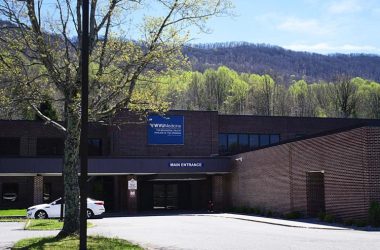HUNTINGTON, W.Va. – With growth of natural gas in West Virginia, there are a number of new pipeline projects proposed for the state, raising a range of debates about the benefits and the risks.
In recent years, the shale revolution has opened access to abundant gas supplies within the state and the region, which has created the need for more infrastructure, according to industry officials.
“Marcellus and Utica gas has been a game-changer for this region,” said Scott Castleman, communication manager for TransCanada, which now owns Columbia Pipeline Group.
“We have 31,000 miles of pipeline, with 15,000 miles on the East Coast that is at capacity,” he said. “We need to increase that capacity.”
The United States already has a massive system of pipelines built over the past 100 years, and they carry various types of oil and gas products.
“Nationwide, some 300,000 miles of natural gas transmission pipelines provide a vital link between producers and consumers,” Castleman said. “Many people are unaware of the presence of this large pipeline network that is operating safely and reliably underground.”
“Pipelines have been transporting hydrocarbons all over the world for nearly 100 years, including across the Ohio River,” said Anne Blankenship, executive director of the West Virginia Oil & Natural Gas Association.
Dramatic gains in crude oil and natural gas production in the U.S. and Western Canada in the past decade has reshaped energy markets and increased demand for pipelines.
“Natural gas has an important role to play in complementing low-carbon energy solutions by providing flexibility needed to support a growing renewables component in power generation,” the International Energy Agency said in a recent report.
The West Virginia Chamber of Commerce says building new, highly efficient pipelines will increase the use of West Virginia’s natural resource and greatly increase its value.
“West Virginia sits on an enormous reserve of natural gas that becomes more useful and valuable if it can be tapped and transported,” said Steve Roberts, president of the West Virginia Chamber of Commerce. “Our state will realize new jobs in construction and maintenance of the pipelines. Counties and our state will see an increase in property and severance tax receipts. Natural gas will help manufacturers have an essential ingredient for the production of many useful products. It is estimated that pipeline completion can add hundreds of millions of new dollars in severance tax collections for our state’s coffers. Workers, schools and our economy all win with the construction of new, efficient natural gas pipelines.”
However, environmentalists see many risks.
“We want to make people aware of the fracking and pipeline threats, especially to the Tri-State region,” said Natalie Thompson, executive director of the Ohio Valley Environmental Coalition (OVEC), based in Huntington.
Thompson says most people don’t know the possibilities of the side effects, health effects and environmental effects from fracked gas pipelines.
“The Huntington area could suffer very high costs to our air, water and quality of life if the fracking and pipeline industries have their way,” Thompson said.
Pipeline proposals
In the Huntington Tri-State region, a total of nine pipelines are proposed to come through the area. They include the Leach Xpress, Mountaineer Xpress, Buckeye Xpress and the Appalachian Storage Hub, which would consist of six pipelines originating in Pennsylvania and running adjacent to the Ohio River along West Virginia’s Ohio River border before crossing under the Ohio River and then passing by Marathon’s refinery in Catlettsburg, Kentucky, and go toward the Gulf Coast.
The proposed Mountaineer XPress, Leach XPress and the Buckeye Xpress all would carry gas from West Virginia, Pennsylvania and Ohio to a pipeline interconnection site near Marathon’s Catlettsburg refinery.
West Virginia University in conjunction with the Benedum Foundation is evaluating the viability of creating a transportation and storage hub for base chemicals in the region. This proposed project is called the “Appalachian Storage Hub.”
“This would effectuate the availability of base chemicals, including ethylene, propylene and chlorine that upon completion could lead to the renaissance of the chemical industry in the region,” Blankenship said. “The hub would also create a liquid trading hub for natural gas liquids and base chemicals, which would allow producers and manufacturers to buy and sell their products locally.”
Process for approval
The process for approval for natural gas pipeline projects is long and complicated.
All the proposed pipelines would be governed by the U.S. Natural Gas Act, which requires a Certificate of Convenience and Necessity from the Federal Energy Regulatory Commission, or FERC, before construction can commence. Under section 7 of the Natural Gas Act, FERC reviews applications for the construction and operation of natural gas pipelines. In its application review, FERC works to ensure that the applicant has certified that it will comply with U.S. Department of Transportation safety standards.
The pipeline projects also must get approval from the West Virginia Department of Environmental Protection as well as the U.S. Army Corps of Engineers.
All of the proposed pipelines for the Huntington region are still in the early stages.
On Monday, March 20, the FERC had a public comment meeting in Hurricane in Putnam County regarding the Draft Environmental Impact Statement (DEIS) for the proposed Mountaineer Xpress pipeline.
At the meeting, several urged approval for the project and its jobs, while others warned of damage from construction, erosion and the aerial herbicide spraying along the right of way that would continue perpetually.
Robin Blakeman, an OVEC organizer, requested an extension of the comment period on the Mountaineer Xpress impact statement of a minimum of one month.
“This is insufficient time to review a 500-plus-page document,” she said.
OVEC claims the impact statement fails to adequately consider the regional cumulative impact of all the proposed pipeline projects in the region in terms of leakages and explosions, habitat fragmentation, impact on human health, impacts of water resources and more.
“FERC should address the fact that this and other pipelines will mean more fracking-related activities for already besieged communities,” Blakeman said.
FERC already has approved TransCanada’s request to construct the Ohio River No. 2 horizontal directional drill in Monroe County, Ohio, and Wetzel County, West Virginia, for the Leach XPress Project.
The $1.4 billion Leach XPress Project involves construction of about 160 miles of natural gas pipeline and compression facilities in southeastern Ohio and West Virginia’s Northern Panhandle. Once completed, it will allow for the transport of 1.5 Bcf/d of natural gas from the Marcellus and Utica supply basin.
It also has been announced that TransCanada/Columbia Gas has formally filed a certificate application with the FERC for its WB XPress Project in West Virginia and Virginia.
The approximately $850 million WB XPress Project will deliver up to 1.3 billion cubic feet per day of Appalachian supply to expanding Mid-Atlantic markets, as well as Gulf Coast markets via a downstream, third-party interstate pipeline expansion from an existing interconnect in West Virginia.
Pending FERC authorization, Columbia expects to commence WB XPress construction in 2017 and place the project in service in the second half of 2018.
Proposed natural gas pipelines in West Virginia
Atlantic Coast Pipeline
The Atlantic Coast Pipeline is a joint proposal by Dominion, Duke Energy, Piedmont Natural Gas and AGL Resources. The pipeline would be about 550 miles long. It would pass through the Monongahela and George Washington national forests and cross both the Appalachian Trail and Blue Ridge Parkway.
Mountain Valley Pipeline
The Mountain Valley Pipeline has been proposed by EQT Corp. and NextEra US Gas Assets LLC. It would be a 330-mile pipeline beginning in Wetzel County, West Virginia, and ending in Pittsylvania County, Virginia, with a possible extension into North Carolina. The current route includes Greenbrier and Summers counties in West Virginia and Montgomery, Roanoke and Franklin counties in Virginia.
Western Marcellus Pipeline
Williams Transco has proposed to build the Western Marcellus Pipeline along a similar route to the Mountain Valley pipeline. It also begins in the Northern Panhandle, and early maps show that it would pass through western Greenbrier, Summers and Monroe counties in southern West Virginia. The pipeline would end in southern Virginia, where it would join with the existing Transco pipeline.
WB XPress Pipeline
The WB XPress Pipeline is an $850 million natural gas infrastructure proposal from Columbia Gas Transmission. The project consists of two new compressor stations, 26 miles of pipeline replacement and 2.9 miles of new pipeline in Virginia and West Virginia.
Leach XPress Pipeline
This 160-mile pipeline would cut through Marshall County in West Virginia. The Federal Energy Regulatory Commission (FERC) issued approval in January 2017. Permits from West Virginia and the Army Corps of Engineers are still needed.
Mountaineer XPress Pipeline
Mountaineer XPress Pipeline would originate in Marshall County and would move fracked gas through north-central West Virginia’s fracking regions, go under the Kanawha River in Putnam County, connect with existing pipeline near Milton in Cabell County and go from there to a proposed new pipeline in Wayne County and on to an expanded Ceredo compressor station near the Huntington Tri-State Airport.
Buckeye XPress Pipeline
Columbia’s newly proposed Buckeye XPress Pipeline is planned to travel through parts of Ohio, Pennsylvania and West Virginia. No route details are available as this project is still in the planning phase.
Rover Pipeline
Rover Pipeline is a new interstate natural gas pipeline that is designed to transport 3.25 billion cubic feet per day of domestically produced natural gas to markets in the Midwest, Northeast, East Coast, Gulf Coast and Canada. The project received a Certificate of Public Convenience and Necessity from the Federal Energy Regulatory Commission on Feb. 2, 2017. Construction will begin the first quarter of 2017, with targeted in-service goals of July 2017 for Phase I and November 2017 for Phase II.
Rover Pipeline will have direct deliveries in Ohio, West Virginia, Michigan and into the Dawn Hub in Ontario, Canada. This will provide a broader network of distribution points back into the U.S., Northeast and Canadian market.
Appalachian Storage Hub
The Appalachian Storage Hub would bring six more pipelines through the greater Huntington region. This would originate at Shell Chemical Co.’s planned and approved ethane cracker in southeast Pennsylvania. It is still in the design and planning phases, but initial plans indicate that all six pipelines would run along the entire length of the West Virginia and Ohio border. Maps show the proposed pipelines running along the Ohio side of the river. The hub would also include a new pipeline connecting Charleston-area petrochemical plants to the hub pipelines near Point Pleasant, West Virginia.





